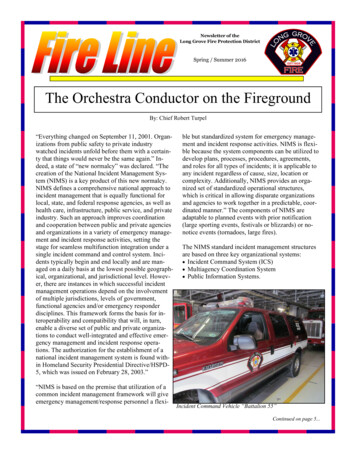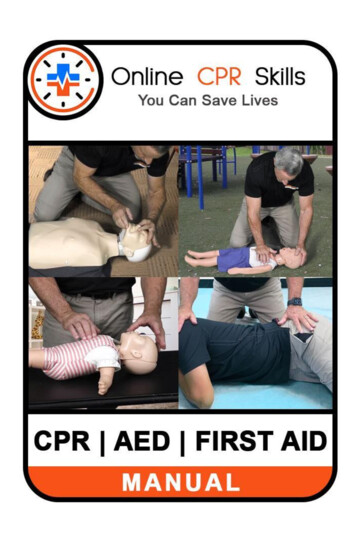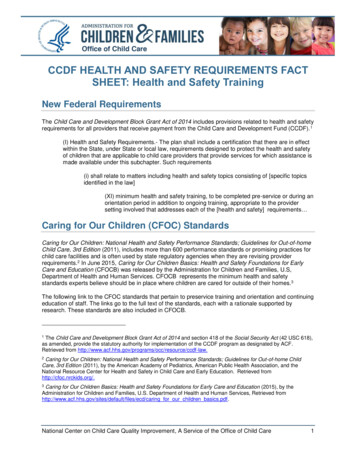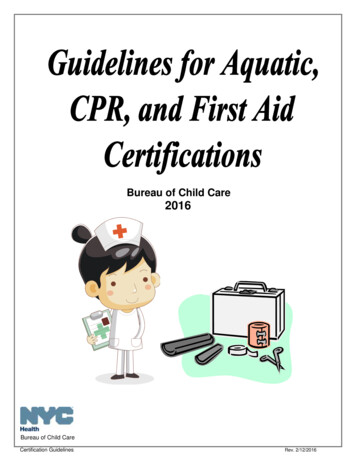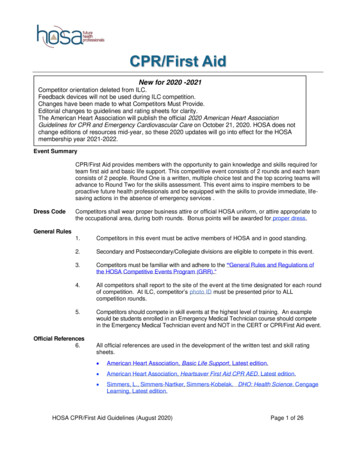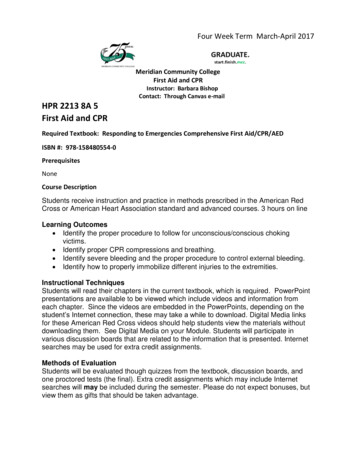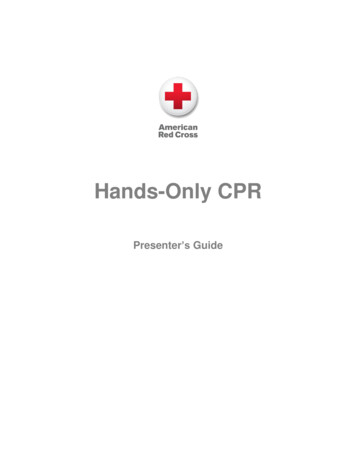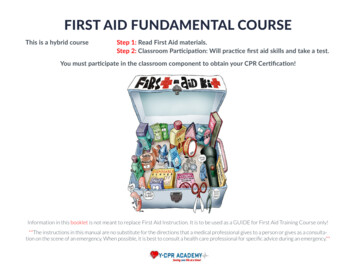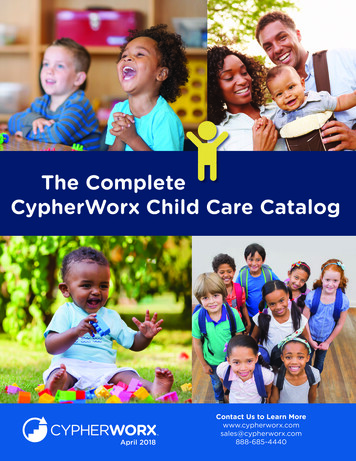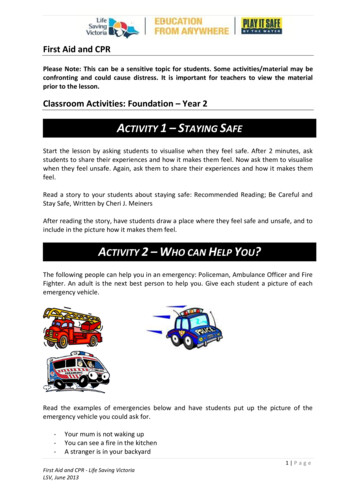
Transcription
First Aid and CPRPlease Note: This can be a sensitive topic for students. Some activities/material may beconfronting and could cause distress. It is important for teachers to view the materialprior to the lesson.Classroom Activities: Foundation – Year 2ACTIVITY 1 – STAYING SAFEStart the lesson by asking students to visualise when they feel safe. After 2 minutes, askstudents to share their experiences and how it makes them feel. Now ask them to visualisewhen they feel unsafe. Again, ask them to share their experiences and how it makes themfeel.Read a story to your students about staying safe: Recommended Reading; Be Careful andStay Safe, Written by Cheri J. MeinersAfter reading the story, have students draw a place where they feel safe and unsafe, and toinclude in the picture how it makes them feel.ACTIVITY 2 – WHO CAN HELP YOU?The following people can help you in an emergency: Policeman, Ambulance Officer and FireFighter. An adult is the next best person to help you. Give each student a picture of eachemergency vehicle.Read the examples of emergencies below and have students put up the picture of theemergency vehicle you could ask for.-Your mum is not waking upYou can see a fire in the kitchenA stranger is in your backyard1 P a g eFirst Aid and CPR - Life Saving VictoriaLSV, June 2013
ACTIVITY 3 – BIG ACCIDENT/LITTLE ACCIDENT GAMEHow does a child know when to call a Triple Zero (000)? Knowing the difference between aBIG accident and a little accident is important. Tell the students that if it is a BIG accident,they should call Triple Zero (000), if they can’t find an adult. The activity below will helpstudents identify what is a BIG accident, and what is a little accident.Have students stand in a circle. Read out examples of accidents below. Explain to studentsthat if they think it is a BIG accident to stay standing up. If they think it is a little accidentthen they should sit down. If they are not sure then they are to kneel.-Your brother has a small cut on his legYour grandma is not breathing normallyYour friend falls out of a tree and cannot moveYour sister has a stomach acheYour father hit his head which is bleeding lots and he cannot talk properlyDiscuss with students after each accident.ACTIVITY 4 – WHAT IS MY ADDRESS & PHONE NUMBER?Knowing your address and home phone number is helpful when speaking to emergencyservices. Provide all students with the template below and have each student write downtheir address and home phone number.If I need help – Call Triple Zero (000)My AddressMy Phone NumberStudents are to take this home and place next to their home phone.2 P a g eFirst Aid and CPR - Life Saving VictoriaLSV, June 2013
Classroom Activities: Years 3 - 4ACTIVITY 1 – SAFE OR UNSAFE?Using the T-Chart template below, students make a list of places where they feel safe andwhere they feel unsafe. The first one has been done for you.SAFEIn my own homeUNSAFEWalking alone in the darkACTIVITY 2 – CHECKING HAZARDSStudents are to complete the checklist below to ensure that there classroom is safe.Teachers and students can change/add to the list below depending on the structure of theclassroom.ClassroomDo you have a visible emergency evacuation plan?Can you get to the exit without tripping over the tables and chairs?Do you have smoke alarms fitted?Are heavy items stored low to stop them from falling?CheckDiscuss as a class: Can you ‘check’ all potential hazards/harms? Why or Why Not?Once all students have completed the above checklist for their classroom, divide thestudents into groups and designate each group a different area of the school. Students areto create and complete a checklist to ensure those areas are safe, i.e. gym, playground,computer lab.Extension Activity: Have students create and complete a checklist for their home.3 P a g eFirst Aid and CPR - Life Saving VictoriaLSV, June 2013
ACTIVITY 3 – SAFETY MONITORSSafety Monitors in the classroom can teach students invaluable life skills includingresponsibility and teamwork.Nominate a different student each week to be responsible for safety in their classroom. Thiscould develop the students’ skills in identifying hazards/harms and consider actions tocreate and maintain a safe environment. Students must report all hazards not safe toremove to the teacher or adult. See below for potential responsibilities:- Pushing in chairsreport hazards- Turning off lights- Complete a daily checklist -RemoveorACTIVITY 4 – COMPARE & CONTRASTAs a class, watch the two videos below about children being recognised for dialling TripleZero (000).http://www.youtube.com/watch?v n3c3qzKdYtc – Ambulance Recognises 6 Year Oldhttp://www.youtube.com/watch?v qHTo8HxYPRI – Toddler Hero HonouredStudents are to compare and contrast the two videos by completing the Venn diagrambelow. Students may also like to draw pictures instead of using words. You may need towatch the videos twice.4 P a g eFirst Aid and CPR - Life Saving VictoriaLSV, June 2013
Classroom Activities: Years 5-6ACTIVITY 1 – ACCIDENTS HAPPENDid you know that injuries are a leading cause of death and hospitalisation among children?Scavenger hunt: Below you will find a list of different accidents or events. As a class, theteacher reads out the accident or event, and students put up their hands if it has happenedto them. The teacher will need to keep a tally of the number of students for the followingactivity.- Been to hospitalsurgery- Had a paper cutoff a bike- Been stung by a bee- Needed stiches-Had- Broken a bone- Grazed their knee- FallenUsing the data above, each student is to create a bar graph which represents the number ofstudents who have been involved in a particular accident or event.ACTIVITY 2 – PREVENTION: AVOIDING DANGERSDivide students into groups of 2-4. Using the table below, students identify potentialhazards in their school and consider changes to improve safety. Three examples have beengiven to you.AreaCar ParkPotential HazardCarsSchool GymLeaking RoofPlaygroundPlay EquipmentImprovement-SignsStaff to be put on dutyIsolate/fence off areaInform teacherInform all students of safe playCreate rules to followExtension Activity – Have students go home and complete the same activity but in their ownhome or in the community, i.e. local park, sporting club, shopping centre.5 P a g eFirst Aid and CPR - Life Saving VictoriaLSV, June 2013
ACTIVITY 3 – ROLE PLAYEveryone has the right to be safe. What strategies can you use to ensure you stay safe athome, at school and in the community? Below is a list of unsafe situations. With a partner,go through and act out how you could respond to each scenario. Your partner will rate youout of 10 in terms of how well they thought you reacted to the situation. The partner mustbe able to explain why they gave you that rating, and suggest alternative strategies.-You are waiting for the bus when a man in a van approaches you and asks you to getin the carYou walk past a group of teenagers who are vandilising your local parkYou get into an argument with a friend who becomes quite angry and aggressiveYou notice a group of people acting strangely in a shopping centre car parkYou can hear loud noises outside your window when you are trying to sleep*Remember – Emergency services should always be called if you are unsure.ACTIVITY 4 – MEMORY GAMETrying to remember things you may have noticed or witnessed in an emergency is notalways easy but you will always be asked this by emergency services. It may be about aperson’s appearance or what actually happened. Writing down information helps, howeveroften you will find you don’t have time when you are trying to deal with the situation.Have the class sit in a circle. Place 10 different items in the centre, i.e. pen, book, and selectone student to be a volunteer. Have the students look at all the items in the circle beforethey leave the room. Select a student to remove an item from the circle. When the studentreturns they firstly need to identify the missing item and then point out the student whotook it. You may like to increase or decrease the number of items in the circle or only allowthe student three guesses to make it easier/harder.Extension Activity: Concentration - Students can create their own set of concentration cardsby making a word and matching picture which relates to the above theme, i.e. Number platematch, word and picture of a moustache. Alternatively, you can play the game ‘Guess Who’.6 P a g eFirst Aid and CPR - Life Saving VictoriaLSV, June 2013
Classroom Activities: Years 7 - 8Please Note: This can be a sensitive topic for students. Some activities/material may beconfronting and could cause distress. It is important for teachers to view the materialprior to the lesson.ACTIVITY 1 – ON A CONTINUUMStart students in the middle of the classroom and identify one side to be ‘Strongly Agree’and the other ‘Strongly Disagree’. Say the statements below and allow students to move towhere they think they fit in the continuum. You can then use this to discuss morals,conscience, attitudes, religion and the law.-I would not help a person I didn’t knowI could perform CPR to a family member or friendCPR should only be taught to adultsI feel confident a family member could save my lifeI would not know what to do in an emergencyStrongly AgreeStrongly DisagreeNeither Agree or DisagreeACTIVITY 2 – IDENTIFYING RISKS: CAUSE AND EFFECTWe take risks everyday which have both positive and negative effects on us. Whilst we needto take these risks, it is also important that we identify potential outcomes. In doing this, wecan then consider strategies to ensure we keep safe. Using the template below, identifyrisks taken on a daily basis and the possible effect they may have. The first one has beendone for you.CAUSE:Riding a BikeEFFECT/S:Enjoyment and laughterIncrease fitness7 P a g eFirst Aid and CPR - Life Saving VictoriaLSV, June 2013
ACTIVITY 3 – PROTECTING YOUR HEALTHIdentifying potential outcomes of risks allows you to develop strategies you can use toensure you stay safe. Next to each negative effect in the above activity, write down how youmay avoid potential harm, i.e. when bike riding, I could wear a helmet to protect my head incase I fall off.ACTIVITY 4 – CALLING TRIPLE ZERO (000)You need to call an ambulance for a friend. You dial Triple Zero (000) and ask the operatorfor an ambulance. Once connected, you are asked a series of questions. Complete theactivity below to help remember what you need to tell the operator in an emergency.Paper fold activity: In groups of 5, each student is to have a blank piece of paper. Divide thepage into five horizontal sections with the following headings:Place (Location of the emergency)Phone (The phone number you are calling from)Problem (What exactly happened)People (Number of people hurt)Progress (Has anything changed)Each person begins with writing the place of the emergency on their piece of paper. Oncewritten, students are to horizontally fold the paper so it can’t be seen and pass to theperson on their right. The next person fills in the 2 nd section; the phone number. Thiscontinues until all sections are completed by a different member of the team. Once it’s backat the start, students are to read aloud what was written.8 P a g eFirst Aid and CPR - Life Saving VictoriaLSV, June 2013
Classroom Activities: Years 9-10ACTIVITY 1 – PAINTING THE PICTURE: THE EVIDENCEIn groups of three, each student selects one of the newspaper articles below. Students areto then read the article, taking notes on what they have read. Once completed, studentscome together in their group and discuss the article and any relevance to 6800ACTIVITY 2 – AVOIDING SITUATIONS: BEING ASSERTIVEPersonal safety is important, but we all know how much peer pressure can influenceadolescence decisions. This task is designed to encourage students to come up withstrategies and communication tools to help alleviate an issue before it arises.Divide class into four groups. Each group is to role play one of the following scenes in frontof the class. Each scenario should include the best way to deal with the situation and how toreact. Be sure to include different strategies to use and discuss alternatives as a class aftereach. Allow students enough time to practice before they present.-Your friends dare you to swim to the other side of a river and you cannot swimYou are in a car with friends going 100kms over the speed limitA mate keeps hassling you to try drugsA stranger begins to follow you and asks you to get in their car9 P a g eFirst Aid and CPR - Life Saving VictoriaLSV, June 2013
ACTIVITY 3 – TRIPLE ZERO (000) KIDS SAVE MUMAs a class, listen to the call made to Triple Zero (000) from the children of a mother who washaving an asthma cq1-1226493942344Watch the call for a second time and students complete a Y-Chart by writing down wordsabout how they felt, what it may have looked like and how it may have sounded, i.e. LookedLike, Felt Like and Sounded Like. Students should share their experience with the personnext to them.Extension Activity - Research Task: What information you will be asked for from theemergency operator? Create a checklist to give to a younger sibling, cousin, next doorneighbour or family friend.ACTIVITY 4 – HOW WOULD YOU REACT?After listening to the call to Triple Zero (000) in the previous activity, how do you think youwould react?In the table below, you have been given three different scenarios. To the best of yourability, write down what you could do to help that person. Discuss as a class.ScenarioWhat may behappening?How could youhelp?Your father is complaining of a tight chestand has a tingling pain in his arms. He tellsyou he is okay, but he still looks to be indiscomfort.Your best mate stacked on his bike. Whilsthe was not wearing a helmet, he managesto stand up and only looks to have minorgrazes. After returning to his house, younotice he forgot what happened.Your younger sister is having a sleepover forher birthday. At dinner, you notice one ofher friends finding it difficult to breathe.10 P a g eFirst Aid and CPR - Life Saving VictoriaLSV, June 2013
Classroom Activities: GeneralACTIVITY 1 – CREATE A VIDEOIn groups of 4-5, students are to create a video titled ‘How to be an Everyday Lifesaver’. Thevideo must demonstrate the DRSABCD Emergency Action Plan by clearly explaining anddemonstrating each step.ACTIVITY 2 – TEACH A FAMILY MEMBERTeach the DRSABCD Emergency Action Plan to a family member or friend. Students mustshow evidence by using one of the following: A checklist to show their competency or asurvey/questionnaire completed by their family member or friend.ACTIVITY 3 – POWERPOINT PRESENTATIONStudents are to create a PowerPoint presentation that they can use to show students in ayounger year level through peer teaching. Older students are required to explain theDRSABCD Emergency Action Plan. Students could present in assembly or actually teach ayounger year level.ACTIVITY 4 – SING A SONGWe all know our favourite songs off by heart, so why not create one for the DRSABCDEmergency Action Plan. You do not have to be a good singer, just a crazy tune which iscatchy and informative. Be as creative as you like! Perhaps the class could perform the songat assembly.ACTIVITY 5 – WRITE A PROCEDURAL TEXTYou are an expert in the field of ‘Saving Lives’ and you have been asked by the producers atABC to write a procedural text about ‘How to be an Everyday Lifesaver’.ACTIVITY 6 – NEWSPAPER ARTICLEYou are a news reporter for Channel 9 and you have been asked to write an article aboutthe 10 year old that acted as an ‘Everyday Lifesaver’ and saved their sibling. The article must11 P a g eFirst Aid and CPR - Life Saving VictoriaLSV, June 2013
include details of the emergency situation and steps the 10 year old took to save theperson’s life (referring to the DRSABCD Emergency Action Plan).ACTIVITY 7 – DESIGN A BROCHUREBrochures are a great way to give people important information. Design a brochure whichcan be placed in the school office for parents to read or take home. Ensure to include theDRSABCD Emergency Action Plan in your brochure.ACTIVITY 8 – POSTER POWERAs a class, create a poster for every room in your school. The poster should clearly outlinethe DRSABCD Emergency Action Plan and be relevant to the area the poster will be placed,i.e. Staff room; very detailed, and Prep classroom; basic with more pictures.ACTIVITY 9 – MAKE A COLOURING SHEETThe local kindergarten has just had a visit from a local paramedic and has asked your schoolto make a range of colouring sheets for their children. The colouring sheets could includehow to call for an ambulance or recognising when someone is in danger.ACTIVITY 10 – RETELL WHAT YOU LEARNTYour mother asks you what you learnt at school today. Excited after the Resuscitate a Mateprogram at your school, you decide to write a recount of everything you learnt, includingthe DRSABCD Emergency Action Plan.ACTIVITY 11 – COMIC STRIPYou work for Herald Sun and it is your role to create the comic strips for every newspaper.Design a comic strip which outlines the DRSABCD Emergency Action Plan. Remember to becreative and include interesting characters to engage the readers.ACTIVITY 12 – BOARD GAMEWe all love playing board games. Trivial Pursuit, Snakes and Ladders, Monopoly andScrabble are often among the most popular. Design a board game or activity sheet whichhelps students learn the DRSABCD Emergency Action Plan. This may also include crosswordsand wordfinds.12 P a g eFirst Aid and CPR - Life Saving VictoriaLSV, June 2013
ACTIVITY 13 – CLASS DEBATEShould all students in Victorian Schools be taught CPR? Divide the class into 2 groups. Onegroup will argue that all Victorian School students should be taught CPR and the other groupis to argue that they shouldn’t. Students should research to support their arguments.ACTIVITY 14 – LETTER TO THE INSTRUCTORWrite a letter to your Instructor thanking them for such a great Resuscitate a Mate program.Be sure to include everything that you learnt. Send your letters to Life Saving Victoria whowill pass them on to the Instructor; 200 The Boulevard, Port Melbourne VIC 3207.ACTIVITY 15 – TRIVIA TEAM CHALLENGESelect 2 students to develop and run a trivia for the class based on what they learnt duringthe program. Students are to place the class into teams of 4-5. Points can be awarded forcorrect answers and team work. The group with the most points are the DRSABCDChampions.13 P a g eFirst Aid and CPR - Life Saving VictoriaLSV, June 2013
First Aid and CPR - Life Saving Victoria LSV, June 2013 First Aid and CPR Please Note: This can be a sensitive topic for students. Some activities/material may be confronting and could cause distress. It is important for teacher
